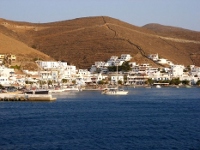 The island of Kythnos is one of the Western Cyclades representatives, located
between Serifos and Kea. Its name derives from the ancient Greek word Kefthemon,
meaning a dim place to hide, since Kythnos was chosen by many as a hiding place
from intruders and pirates of nearby settlements. It is also known as Thermia
in ancient times because of the thermal springs found in the village of Loutra
(around 12th century).
The island of Kythnos is one of the Western Cyclades representatives, located
between Serifos and Kea. Its name derives from the ancient Greek word Kefthemon,
meaning a dim place to hide, since Kythnos was chosen by many as a hiding place
from intruders and pirates of nearby settlements. It is also known as Thermia
in ancient times because of the thermal springs found in the village of Loutra
(around 12th century).
The island is characterized by its serene atmosphere so travelers should not
expect to find an intense nightlife or any big clubs. It offers natural walking
paths and landscapes for those who are interested in hiking.
The towns and villages of Kythnos
Chora and Driopida are the two main inland villages and there are also three main coastal settlements, the Merihas harbour, Loutra with its natural hot springs and Panagia Kanala with its homonym church. Amongst smaller settlements one can find Agios Dimitrios, Episkopi, Kalo Livadi etc.
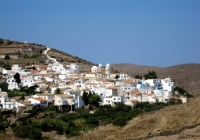 CHORA:
Chora, the capital of Kythnos (also known as Messaria) is build amphitheatrically
on a hill and at a distance of 8 km from the port of Merihas. Alike all islands
of the Cyclades the capital of Kythnos is a picturesque village with white
washed houses, scenic churches and narrow paved alleys that have remained intact
since the 17th century. The beautiful little squares offer some nice restaurants
and cafes blending tradition with modernity. The capital is the largest village
on the island and hosts the oldest church in Kythnos, the church of Agia Triada
(Holy Trinity).
CHORA:
Chora, the capital of Kythnos (also known as Messaria) is build amphitheatrically
on a hill and at a distance of 8 km from the port of Merihas. Alike all islands
of the Cyclades the capital of Kythnos is a picturesque village with white
washed houses, scenic churches and narrow paved alleys that have remained intact
since the 17th century. The beautiful little squares offer some nice restaurants
and cafes blending tradition with modernity. The capital is the largest village
on the island and hosts the oldest church in Kythnos, the church of Agia Triada
(Holy Trinity).
DRIOPIDA: The picturesque village of Driopida, also known as Syllaka, is on the southern side of the island, at a distance of 8 km from Chora and used to be the ancient capital and administrative center of the island. The unique tiled roofs, the winding narrow streets and the numerous fig trees dotted on the mountains create a scenic setting and a sense of serenity. It has a very interesting architectural style, as all houses have two storeys and red-tiled roofs, an unusual feature for the islands of Cyclades. Galatas is one of the most picturesque quarters of the village, with many impressive churches. The most notable is the church of Agios Minas with a wooden-carved temple and a bishop throne, elaborate samples of folk art. The central square called Piazza has many traditional coffee places (kafenia), where you can enjoy local homemade spoon sweets along with your coffee.
Places of interest in Dryopida: the Folkore Museum found in Galatas and the old aqueduct of Dourakas, the Byzantine ecclesiastical museum and other historical churches, such as the church of Saint Panteleimon with the impressive stone bell tower and the church of Holy Trinity. Here you will also find Cave Katafyki, one of the largest and most impressive caves in Greece, with beautiful stalactites and stalagmites formations. Many excursions are possible from Driopida as close beaches have intense beauty and unique character. Heading to the west, you shall meet Flabouria, a large beach with sand and thin pebbles, and the old church of Panagia Flabouriani dominating on the rocks above the bay. If you continue to the south west, you will find the beaches of Mavrianos, Trivlakas, Divlakas Stifo, as well as small secluded bays with crystal waters. The beaches in this region are nice and remote, away from crowds.
 MERIHAS:
Merihas is the main port of Kythnos. This is the first scene of the island that visitors
get as the ferry is approaching the port. Merihas is worth to visit for your afternoon coffee
with view to the lovely sunset. The two main roads of the island start from Merihas. After
Merihas is Episkopi, a lovely place with sandy beach and tamarisks almost reaching the sea.
MERIHAS:
Merihas is the main port of Kythnos. This is the first scene of the island that visitors
get as the ferry is approaching the port. Merihas is worth to visit for your afternoon coffee
with view to the lovely sunset. The two main roads of the island start from Merihas. After
Merihas is Episkopi, a lovely place with sandy beach and tamarisks almost reaching the sea.
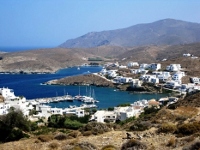 LOUTRA :
Renowned for the thermal springs with the therapeutic properties the small village of
Loutra has become a popular tourist place on the island of Kythnos, also thanks to the
natural beauty and a variety of accommodation options. Besides Merihas, Loutra is the
only other part of the island that counts for a relatively lively nightlife with numerous
cafes, taverns and ouzo restaurants and bars attracting mostly the eldest crowds. The
seaside village is located on the north eastern side of Kythnos, 11 km from the port of
Merihas and 4.5 km from Chora.
LOUTRA :
Renowned for the thermal springs with the therapeutic properties the small village of
Loutra has become a popular tourist place on the island of Kythnos, also thanks to the
natural beauty and a variety of accommodation options. Besides Merihas, Loutra is the
only other part of the island that counts for a relatively lively nightlife with numerous
cafes, taverns and ouzo restaurants and bars attracting mostly the eldest crowds. The
seaside village is located on the north eastern side of Kythnos, 11 km from the port of
Merihas and 4.5 km from Chora.
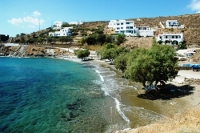 Heading north along the coastline, you shall meet some of the most beautiful beaches in Kythnos,
like Schinari and Potamia, as well as Kavouroheris,
Maroulas and Agios Sostis with the beautiful
chapel. All the mentioned beaches are calm and not affected by the wind, with golden sand or thin
colorful pebbles. For hiking one should explore the bay of Mamakos.
Heading north along the coastline, you shall meet some of the most beautiful beaches in Kythnos,
like Schinari and Potamia, as well as Kavouroheris,
Maroulas and Agios Sostis with the beautiful
chapel. All the mentioned beaches are calm and not affected by the wind, with golden sand or thin
colorful pebbles. For hiking one should explore the bay of Mamakos.
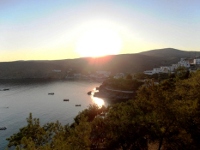 PANAGIA KANALA:
Kythnos is particularly famous for the pilgrimage to the church of Panagia Kanala. In this sacred
location, the pine forest is harmonically combined with golden beaches, while from the picturesque
coves visitors dive in the vastness of the Aegean Sea. The village took its name from the church
of Panagia Kanala, the protector of the island. In this church you can see the miracle-working
icon of Panagia, which was found by fishermen in a canal as the tradition says. On the right side
of the church, there is a nice beach with deep blue water. Behind this beach, there is a second
smaller beach with blue green water.
PANAGIA KANALA:
Kythnos is particularly famous for the pilgrimage to the church of Panagia Kanala. In this sacred
location, the pine forest is harmonically combined with golden beaches, while from the picturesque
coves visitors dive in the vastness of the Aegean Sea. The village took its name from the church
of Panagia Kanala, the protector of the island. In this church you can see the miracle-working
icon of Panagia, which was found by fishermen in a canal as the tradition says. On the right side
of the church, there is a nice beach with deep blue water. Behind this beach, there is a second
smaller beach with blue green water.
AGIOS DIMITRIOS: On the southern side of the island is Agios Dimitrios, the most faraway village from Chora. This is a picturesque village with traditional taverns along its sandy beach. Large tamarisks and rocky formations make this place very interesting, while in August white lilies grow on the sand. From the village of Agios Dimitrios you can easily reach Petroussa and Alyki, two beaches with wild, virgin landscape. With car or boat, you can visit the beaches of Simousi, Gaidouromantra and Skylou, ideal places if you are looking for calm, sandy beaches.
The beaches of Kythnos
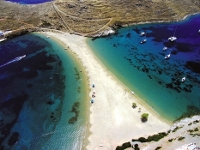 The island of Kythnos is renowned for over 70 different natural beaches (non-organized),
secluded coves and crystalline emerald waters ideal for snorkeling or scuba diving, among
which the famous ones are Agios Sostis, Kastelas,
Sarantos, Kolona and the isolated beaches
of Agios Ioannis and Simousi.
The island of Kythnos is renowned for over 70 different natural beaches (non-organized),
secluded coves and crystalline emerald waters ideal for snorkeling or scuba diving, among
which the famous ones are Agios Sostis, Kastelas,
Sarantos, Kolona and the isolated beaches
of Agios Ioannis and Simousi.
Worth visiting on Kythnos:
- The Church of Panagia Kanala: Overlooking the emerald waters of the sea, Panagia Kanala, the protector of the island is distinguished for its unique architecture. Surrounded by a gorgeous garden, this church is known for the icon of Virgin Mary known to work miracles. Panagia Kanala is the patron saint of the island celebrated on August 15th.
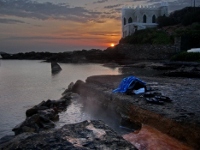 The Thermal Springs Of Loutra:
The thermal springs are in use since the Roman times, but they became widely famous
after the doctors and chemists of king Otto of Greece ascertained their therapeutic
facilities, in the middle of the 19th century. It has been proved that the waters of
these springs help in the treatment of various diseases, like rheumatics, arthritis,
sciatica and gynaecological problems
The Thermal Springs Of Loutra:
The thermal springs are in use since the Roman times, but they became widely famous
after the doctors and chemists of king Otto of Greece ascertained their therapeutic
facilities, in the middle of the 19th century. It has been proved that the waters of
these springs help in the treatment of various diseases, like rheumatics, arthritis,
sciatica and gynaecological problems
- Monastery Of Panagia Nikous In Chora: it is located just outside Chora and has an intense historical and architectural interest. Apparently the monastery has been constructed on the ruins of an ancient temple. Its architecture is austere, following the typical style of the post-Byzantine churches in the Aegean islands. For more than 40 years (until 1833), an educational center was operating in this monastery, where local children but also children from the entire Greece were studying and the teachers were important personalities. It is said that the icon of the monastery was first transferred to Kythnos from Constantinople, and then it was taken to the Basilica of San Marco in Venice, where it is hosted till today. On August 15th, one of the most famous religious festivals (panigiri) of Kythnos is organized in this monastery. On the previous day, stuffed tomatoes and meat dishes are offered to visitors, according to the local custom.
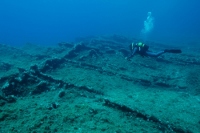 Castle Of Oria (Kefalokastro):
The Castle of Oria is found on the northern side of the island, close to Cape Kefalos
and between the hills Gialoudi and Sklavos, where one can see the remains of two churches
as well as of some ancient murals. Other than its remains, Oria Castle is a site worth
visiting for its breathtaking views. This Castle hosted the capital of Kythnos in the
Byzantine times, as the elevated location and the natural fortification could offer
protection to the inhabitants. According to the tradition, the Castle fell to the
enemies after betrayal and constituted a base of operations for pirates. Access to
the Castle is possible by foot from Loutra or by jeep. Also worth visiting nearby are
the beaches of Kakorema, Gialoudi and Selino.
Castle Of Oria (Kefalokastro):
The Castle of Oria is found on the northern side of the island, close to Cape Kefalos
and between the hills Gialoudi and Sklavos, where one can see the remains of two churches
as well as of some ancient murals. Other than its remains, Oria Castle is a site worth
visiting for its breathtaking views. This Castle hosted the capital of Kythnos in the
Byzantine times, as the elevated location and the natural fortification could offer
protection to the inhabitants. According to the tradition, the Castle fell to the
enemies after betrayal and constituted a base of operations for pirates. Access to
the Castle is possible by foot from Loutra or by jeep. Also worth visiting nearby are
the beaches of Kakorema, Gialoudi and Selino.
